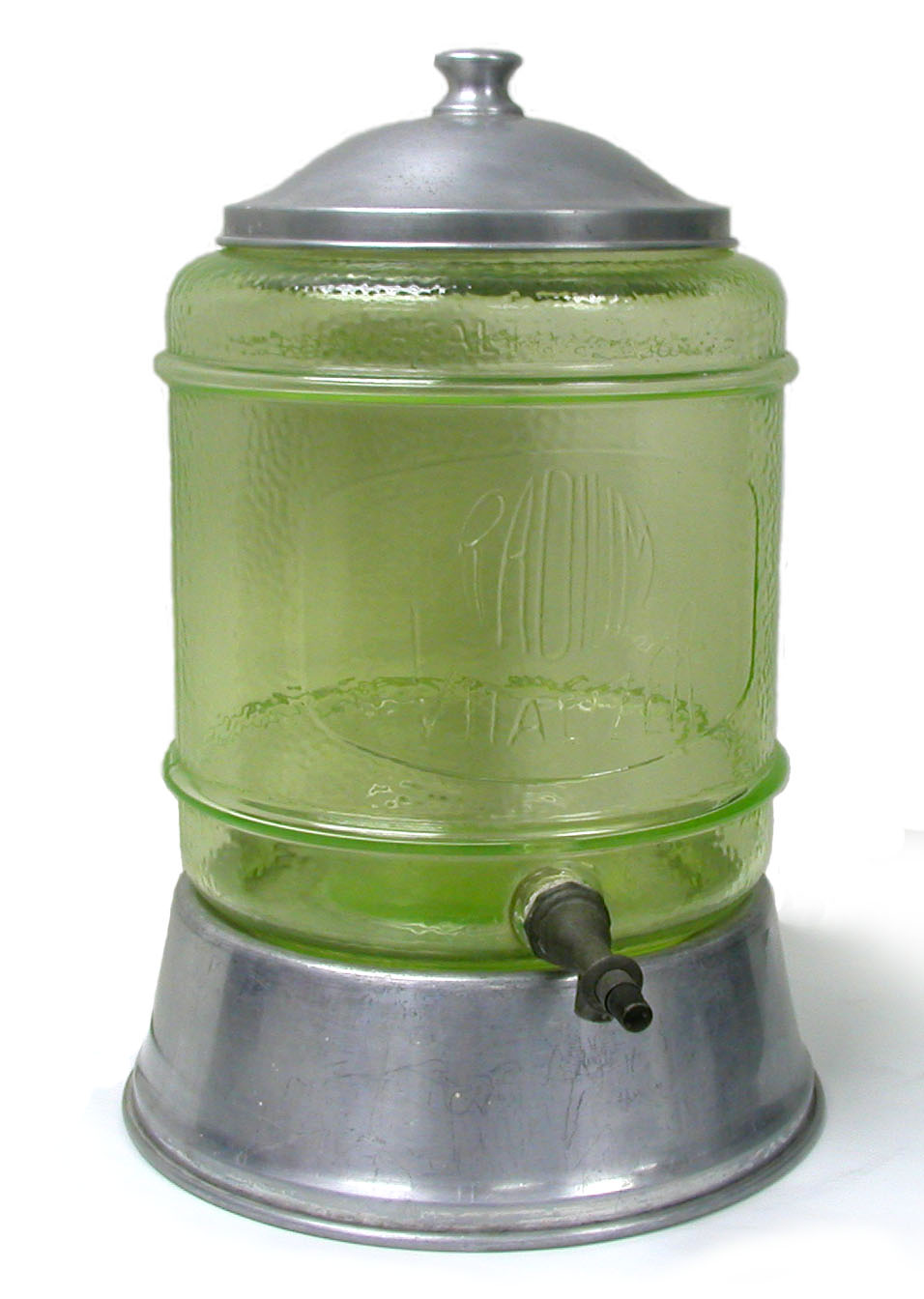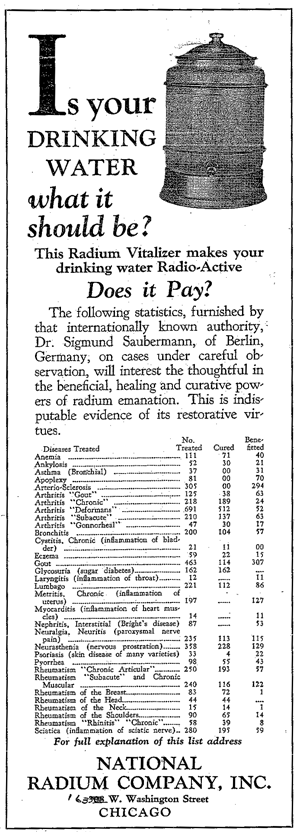Radium Vitalizer Health Fount (ca. 1927-1931)

The Radium Vitalizer Health Fount jar featured here was produced by the National Radium Company. Its purpose: to add radon (radium emanation) to drinking water.
As you can probably tell, the body of the Health Fount was made of uranium-containing vaseline glass, while the lid and base were aluminum.
The words "Health Fount" are embossed in the glass just below the aluminum lid. Under the best of circumstances, the words are almost impossible to see. Nevertheless, if you look carefully, you might be able to make out the "A" and the "L" in "HEALTH." In larger letters in the middle of the jar are the words "RADIUM VITALIZER."
The source of the radon, known as the "Radium Unit," was a blue ceramic cylinder (7” high) that would be placed inside the glass jar. A double row of holes around the unit allowed the water in the jar to circulate through the source. Unfortunately, our jar is missing the source. Then again, that might be a good thing.
Size: ca. 18" high, 10" diameter
Directions for Using the Jar
"First, rinse the Radium Unit with clear water. DO NOT USE SOAP ON THE UNIT. Then, after washing the Crystal container, set the Radium Unit in it. Fill the container with drinking water. Make it a habit of replacing, each night, the water drawn out during the day. If the water has a peculiar taste at first, the Unit may be rinsed each night for the first week. Cleaning once each week will suffice. WE BENEFIT MOST BY DRINKING CONSISTENTLY."
My best guess is that the National Radium Company was born out of the remnants of the National Radium Corporation—the latter collapsed in 1927 when its President, William Bryan, was killed in a car accident. The headquarters for Bryan’s National Radium Corporation headquarters were in Denver, but they also had a facility/office in Chicago. It seems likely that this Chicago operation (the Radium Products Corporation) became the National Radium Company.
The National Radium Corporation produced the Lifetime Radium Vitalizer jar from 1925 to 1927. Later, from about 1927 to 1932, the National Radium Company produced the Radium Vitalizer Health Fount jar. The similarity in the company and product names was mirrored by the physical similarity of the two jars (e.g., overall shape and aluminum lids).
Neither company lasted very long. That the National Radium Company shut its doors by 1933 is indicated by the fact that in March of that year the Federal Trade Commission dropped a complaint against the company because the “respondent has ceased doing business” (Docket 3072. FTC Decisions. Vol. 17). The complaint in question: “Advertising falsely or misleadingly as to the nature and results of product; in connection with the manufacture and sale of a certain water container, termed by it “Radium Vitalizer.”
National Radium Company Addresses
- 163 West Washington Street, Chicago, Illinois
- 308 West Washington Street, Chicago, Illinois
- 30 N. La Salle St., Chicago, Illinois
The La Salle Street address was either associated with the company and/or one of the individuals involved with the company (Manufacturing News. Vol. 35, p. 58. 1929). What is interesting is that this address had previously been occupied by the Radium Products Corporation. The latter, I believe, was the Chicago branch of the Denver-based National Radium Corporation.
The following four individuals were linked to the National Radium Company in a 1929 issue of Manufacturing News (Vol. 35, p. 58).
- Hugh M. Armstrong. He was the key player and the one primarily responsible for managing the company operations.
- John S. Lincoln. As described in the 1930 census, Lincoln was an investment broker. Presumably his role was to obtain the necessary funding for the company and manage its finances.
- Clyde Oscar Hornbaker. Since Hornbaker was a lawyer, his main role might have involved keeping the National Radium Company out of trouble.
- Edward D. Cooley. Cooley was a salesman for the company (J. Medical-physical Research. 1928). The 1930 census described him as a salesman in the radium business.
Confirming a relationship between Hugh Armstrong and William Bryan would be an important piece of the National Radium Company story. While, I have no direct evidence that they knew each other, there is circumstantial evidence that points in that direction.
At the same time that Armstrong was mining radium in Utah and Colorado (ca. 1914 to 1922), William Bryan was in the ore processing business and based in Denver. Surely it is reasonable to speculate that they crossed paths.
Following the collapse of the US radium mining industry in 1922/1923, Armstrong moved to Chicago while Bryan remained in Denver. Around 1925, Bryan formed the National Radium Corporation and served as its president. Although its headquarters was in Denver, the National Radium Corporation also had an office in Chicago. This is pure speculation, but I suspect that Armstrong was in charge of the Chicago office where he oversaw the production of the Lifetime Radium Vitalizer water jar.
A biography of Hugh Armstrong in the July 22, 1959 issue of the Fork Hill Evening Herald described this period in Armstrong’s life as follows:
“because of his extensive knowledge of the whole field of mining and radium, he soon found himself in an office in Chicago where he was making contacts with Chicago physicians and supplying radium in a liquid form.”
Following William Bryan’s death in 1927, the National Radium Corporation went out of business and the National Radium Company began producing the Radium Vitalizer Health Fount in Chicago. Armstrong was definitely associated with the National Radium Company, and most likely served as its president.
Unfortunately for Armstrong, this was a bad time to be peddling radioactive water. His biography in the Evening Herald’s stated:
“over night the American Medical Association clamped down on the soluble radium dispensing business. Armstrong found himself out of a job”
This is somewhat misleading in that it was the Federal Trade Commission that “clamped down” on the National Radium Company. Either way, the bottom line remained the same—Armstrong was no longer dispensing radioactive water.
At some point in the early 1930s, Armstrong became an employee of the Radium Extension Service of Chicago. While there, he seems to have played a role in providing radium to the Elgin State Hospital for their human experimentation studies. In retrospect, that was a good reason to get out of town. And get out of Chicago he did. In 1936, Armstrong moved to South Carolina to manage a gold mining operation.
Just as he had failed to turn a profit mining radium, Armstrong failed to make money in the gold mining business. So he gave up on precious metals and purchased a 650 acre ranch in the Kings Creek—Smyrna region of South Carolina where he raised cattle and for a time, turkeys (Fork Hill Evening Herald. July 22, 1959).
Timeline for Hugh M. Armstrong
| Date | Activity |
|---|---|
| 1881 | Hugh M. Armstrong is born May 3, 1981 in Pittsburgh Pennsylvania. |
| 1904 | He marries Vida V. VanDyke. |
| 1909 | He moved to Grand Junction Colorado to search for gold. |
| ca. 1914 | Armstrong moved to Utah to work the Polar Mesa Mine near Moab for radium |
| 1921 | Armstrong was living in Grand Junction, Colorado. |
| ca. 1923 | Armstrong moved to Chicago. |
| 1925-1927 | Armstrong is possibly working at the Chicago branch of the National Radium Corporation |
| 1929 | He is involved with the National Radium Company, probably acting as its president |
| 1930 | The 1930 census described him as a salesman in the radium industry |
| ca. 1932 | Armstrong is working for the Radium Extension Service of Chicago |
| 1936 | Armstrong moved to South Carolina to manage a gold mine operation |
| ca. 1940 | Armstrong purchased a ranch and is identified in the 1940 census as a farmer. |
| 1965 | Hugh M. Armstrong dies in June of 1965. |
References
Product Literature. No date.

